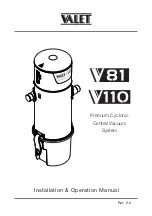
14
| English
Technical data
All-purpose dust extractor
GAS 25 L SFC
Article number
0 601 979 1..
Rated voltage
V
220–240
Rated power input
W
1200
Frequency
Hz
50–60
Container volume (gross)
l
25
Net volume (liquid)
l
16
Dust bag volume
l
9
Max. vacuum
A)
– Dust extractor
hPa
235
– Turbine
hPa
270
Max. volume flow rate
A)
– Dust extractor
l/s
m
3
/s
42
0.042
– Turbine
l/s
m
3
/s
73
0.073
Max. suction power
W
1400
Area of pleated filter
m
2
0.43
Dust class
L
Weight according to EPTA-Pro-
cedure 01:2014
kg
11.8
Protection class
/ I
Dust extractor protection rating
IP24
Mains plug Switzerland protec-
tion rating
IP55
A) Measured using a vacuum hose 3 m long and 35 mm in diameter
The specifications apply to a rated voltage [U] of 230 V. These spe-
cifications may vary at different voltages and in country-specific mod-
els.
Noise Information
Noise emission values determined according
to
EN 60335-2-69
.
Typically the A-weighted sound pressure level of the dust ex-
tractor is less than 70 dB(A). Uncertainty K = 3 dB. The
noise level when working can exceed the volume stated.
Wear hearing protection!
Assembly
u
Pull the plug out of the socket before cleaning or per-
forming maintenance on the vacuum cleaner, making
tool adjustments, changing accessories or putting
away the vacuum cleaner.
This safety measure prevents
the vacuum cleaner from being started accidentally.
Fitting the Vacuum Hose (see figure A)
– Attach the vacuum hose
(8)
to the hose adapter
(7)
and
turn it clockwise as far as it will go.
– Insert the suction tubes firmly into one another.
Note:
The friction generated by the dust in the vacuum hose
and accessory during extraction causes an electrostatic
charge that the user may experience as static discharge (de-
pending on environmental factors and their physiological
state).
Bosch generally recommends using an anti-static vacuum
hose (accessory) to vacuum up fine dust and dry materials.
Changing/Inserting the Dust Bag (see figure A)
– Open the catches
(10)
and remove the dust extractor lid
(3)
.
– Pull the full dust bag
(11)
backwards out of the connec-
tion flange. Close the opening in the dust bag by turning
down the top. Take the closed dust bag out of the vacuum
cleaner.
– Place the new dust bag
(11)
over the dust extractor's
connection flange. Make sure that the entire length of the
dust bag
(11)
touches the inside wall of the
container
(9)
. Put the top part of the dust extractor
(3)
on.
– Close the catches
(10)
.
You should use a dust bag
(11)
for dry extraction. Using a
dust bag
(11)
keeps the pleated filter
(12)
clear for longer,
the suction power is maintained for longer and it is easier to
dispose of dust.
Operation
u
Pull the plug out of the socket before cleaning or per-
forming maintenance on the vacuum cleaner, making
tool adjustments, changing accessories or putting
away the vacuum cleaner.
This safety measure prevents
the vacuum cleaner from being started accidentally.
Start-up
u
Pay attention to the mains voltage.
The voltage of the
power source must correspond with the information on
the type plate of the dust extractor. Dust extractors
marked with 230 V can also be operated with 220 V.
u
Make sure you inform yourself about the applicable
regulations/laws on how to handle harmful types of
dust in your country.
The dust extractor may be used for vacuuming and extract-
ing the following materials:
– Dusts with an exposure limit of > 1 mg/m
3
u
Products that are only sold in AUS and NZ:
Use a resid-
ual current device (RCD) with a nominal residual current
of 30 mA or less.
The dust extractor must categorically not be used in poten-
tially explosive areas.
To ensure optimum suction power, you must always fully un-
wind the vacuum hose
(8)
from the top part of the dust ex-
tractor
(3)
.
1 609 92A 6U5 | (04.07.2022)
Bosch Power Tools















































